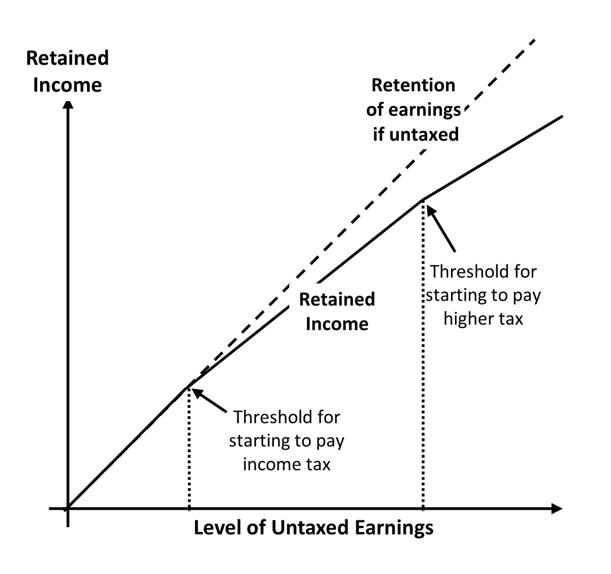3.2.4.1 Progressive Taxation
Progressive taxation reduces economic inequality
Some taxes are designed to be levied at a higher percentage upon those who have greater wealth in that category: they are ‘progressive’. The justification for such a policy is discussed later in this chapter, as an extension to ‘economic reciprocity’ (3.5.1.2).
Income taxes, for example, tend to be progressive. They typically take the form of allowing all income below a certain threshold to be free of tax and then taxing the remainder. Usually, a higher tax rate is applied as incomes exceed a further threshold, on the principle that the rich can afford to pay even more – as in the simplified example illustrated below, which rises from 0% to 20% to 40%.
The American 2019-2020 Tax Brackets and Federal Income Tax Rates, as published by Nerdwallet, and British Income Tax rates and allowances for current and past years, are progressive – as are those in most other countries.
Property, inheritance and capital gains taxes are also progressive: they mostly affect wealthy people. Thomas Piketty proposed the “Utopian idea” of a “progressive global tax on capital”, in chapter 15 of his book Capital in the Twenty-First Century, according to an Economist overview: Reading “Capital”: Part 4, Conclusion, and recap.
Hong Kong, Singapore and Denmark use land value taxes. They are easy to administer and are progressive, as described in David Cooper’s article We need a land value tax to stop home owners getting money for nothing. Even if pensioners with expensive houses might have low incomes, as is sometimes argued, they could afford to pay a land tax by taking out a loan on the value of their houses. They would have less to pass on to their heirs, but that can be justified on the basis that inheritance is also unearned.
Whereas progressive taxation reduces economic inequality, ‘regressive’ taxation does the opposite. For example, the American Social Security Fact Sheet in 2017 revealed that its Social Security tax deductions were regressive: only applying to incomes up to $127,200. Purchase taxes (including value-added tax) also tend to be regressive on many commodities, because poorer people spend a higher proportion of their incomes on basic requirements.
Tax is directly proportional to income in a ’flat tax’ system: it is neither progressive nor regressive. Its proponents, some of whom are libertarians, argue that it stimulates growth by avoiding ‘penalising’ high earners. For example, the Heritage Foundation published A Brief Guide to the Flat Tax, which advocates it:
“Unlike the current system, a flat tax is simple, fair, and good for growth. Instead of the 893 forms required by the current system, a flat tax would use only two postcard-sized forms: one for labor income and the other for business and capital income.”
Although the Heritage Foundation describes this as “fair”, wealthy people would benefit most from its adoption: they would pay much less tax than under the current system. Economic inequality would increase sharply.
This page is intended to form part of Edition 4 of the Patterns of Power series of books. An archived copy of it is held at https://www.patternsofpower.org/edition04/3241a.htm
